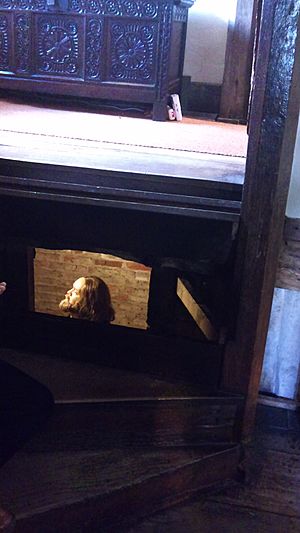Priest hole facts for kids
A priest hole was a secret hiding place built into many large Catholic homes in England, Wales, and Ireland. These hidden rooms were used during a time when Catholics faced harsh laws and were often persecuted. When Queen Elizabeth I became queen in 1558, there were plots against her, and strict rules were made against Catholic priests. Many big houses then had priest holes built. This allowed priests to hide when officials searched the buildings. These secret spots were hidden in walls, under floors, behind wood panels (called wainscoting), and in other clever places. They were often very good at keeping the priests safe.
Many priest holes were designed by a Jesuit brother named Nicholas Owen. He spent much of his life building these secret places to protect priests who were in danger. After the Gunpowder Plot, Owen was captured. He was taken to the Tower of London and died after being severely questioned and tortured on a device called the rack. He was later recognized as a martyr (someone who dies for their beliefs) by Pope Paul VI in 1970.
Contents
Why Priest Holes Were Needed
The laws against Catholics became much stricter after events like the Rising of the North in 1569 and especially the Babington Plot. The government became very harsh towards seminary priests (priests trained abroad). People called "Priest hunters" were hired to find information and locate any priests.
A law was passed that said if a member of the Roman Catholic Church performed a religious service, they would lose their property for the first time. For the second time, they would go to prison for a year, and for the third time, they would be imprisoned for life. Anyone who refused to take the Oath of Supremacy (an oath saying the Queen was the head of the Church) was called a "recusant" and was seen as committing high treason (a serious crime against the country).
Another law said that if a "papist" (a term used for Catholics) tried to convert an Anglican or other Protestant to Catholicism, both would be put to death for high treason. For example, in November 1591, a priest was hanged outside a house in Gray's Inn Fields because he had held a Mass there the month before. After the Gunpowder Plot in 1605, during King James I's rule, laws against priests and "Recusants" were enforced even more strictly. If a priest was arrested, it usually meant imprisonment, and often torture and execution.
Where Priest Holes Were Built

Many English castles and large country houses already had ways to hide or escape quickly if there was a surprise attack. But during the time when Catholics were persecuted, the number of secret chambers and hiding places grew in the homes of old Catholic families.
These secret spots were often hidden rooms or chapels in quiet parts of the houses, or even in the roof space. This allowed Mass (a Catholic religious service) to be held in private and safely. Nearby, there was usually a cleverly designed hiding place. This was not only for the priest to slip into quickly in an emergency, but also to store important items like vestments (special clothes for priests), sacred vessels, and altar furniture. Priest holes were built in fireplaces, attics, and staircases. Most of them were constructed between the 1550s and 1605.
Map of all buildings and sites known or believed to have Priest Holes
Nicholas Owen's Designs
Many of these amazing hiding places are believed to have been designed by a Jesuit lay brother named Nicholas Owen. He spent most of his life building these secret spots to protect the lives of persecuted priests.

Sometimes, priest holes were built as a secret side room off a chimney. Another common way to enter was from behind panelling (wooden wall coverings). An example of this can be seen at Ripley Castle in North Yorkshire. Other priest holes were hidden inside water closets (toilets), like at Chesterton Hall, near Cambridge. Harvington Hall in Worcestershire is famous for having seven priest holes throughout the house. These include access through the main staircase, behind wall panels, and even through a false fireplace.
After the Gunpowder Plot, Nicholas Owen himself was caught at Hindlip Hall, Worcestershire. He was taken to the Tower of London and died after being severely questioned and tortured on a device called the rack. He was later canonised (declared a saint) as a martyr by Pope Paul VI in 1970.
How Well Priest Holes Worked
Priest holes were very effective. They successfully confused the thorough searches carried out by the "pursuivants" (the priest-hunters). Old stories describe how difficult it was for the search parties to find them. These searchers would bring skilled carpenters and masons with them. They would try every possible method, from carefully measuring and tapping walls to physically tearing down wall panels and pulling up floors.
Another trick the searchers used was to pretend to leave. They hoped the priest would then come out of hiding. A priest might be half-starved, cramped, sore from being hidden for a long time, and almost afraid to breathe. This was because the smallest sound could make the searchers suspicious of where he was hidden.
See also
- Priest hunter
- Anti-Catholicism in the United Kingdom
- English and Irish Penal Laws
- Come Rack! Come Rope!

